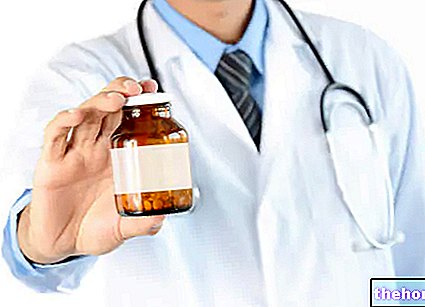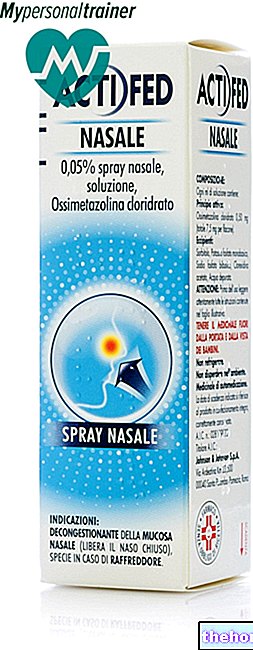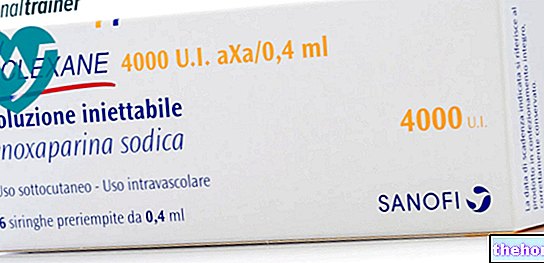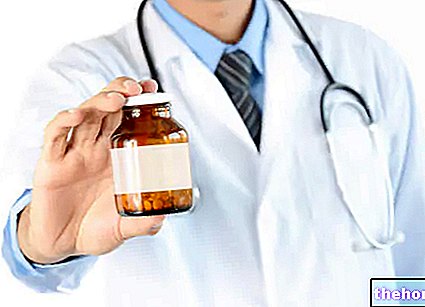Active ingredients: Glutathione
TAD® 600 mg / 4 ml powder and solvent for solution for injection
Why is Tad 600 used? What is it for?
PHARMACOTHERAPEUTIC CATEGORY
Glutathione is a physiological tripeptide that intervenes in numerous biological processes and plays an important role in detoxification reactions, protecting cells from the harmful action of xenobiotic agents, environmental and intracellular oxidants and radiation.
Parenterally administered glutathione belongs to the pharmacotherapeutic group of antidotes.
THERAPEUTIC INDICATIONS
Prophylaxis of neuropathy following chemotherapy treatment with cisplatin or analogues.
Contraindications When Tad 600 should not be used
Hypersensitivity to the active ingredient.
Precautions for use What you need to know before taking Tad 600
None in particular.
Interactions Which drugs or foods can modify the effect of Tad 600
No cases of drug interactions with glutathione are described.At the recommended doses, TAD does not interfere with the therapeutic activity of the chemotherapeutic agent.
Warnings It is important to know that:
The available data indicate that glutathione, due to its nature as a substance physiologically present in cells, does not give rise to undesirable effects in pregnant or lactating women. Animal studies do not indicate direct or indirect harmful effects in relation to pregnancy, embryo-fetal development, childbirth or postnatal development.
In children, safety and efficacy have not been established.
Warning: The products for parenteral use must be visually inspected, before administration, when the container or solution allows it, to detect the possible presence of particles or anomalous coloring. Do not use if cloudiness or precipitate is observed.
KEEP OUT OF THE REACH AND SIGHT OF CHILDREN.
Dosage and method of use How to use Tad 600: Dosage
Dosage
The generally recommended daily dose of TAD in patients receiving cisplatin or analogue chemotherapy is 1.5 g / m2 (corresponding to 2500 mg) administered slowly intravenously. However, the dosage is dependent on the age, weight and clinical condition of the patient, and should also be correlated with the dose and dosage regimen of the chemotherapy. In case of administration of glutathione in combination with the chemotherapy, intravenous infusion of TAD should occur within 15 to 30 minutes prior to the start of chemotherapy.
In the event of long-term therapies, the lowest doses of the product (600 mg) can be used to be administered intramuscularly or slowly intravenously.
Method of administration
Reconstitute the solution in the vial of powder by withdrawing the water contained in the solvent vial using a syringe equipped with a suitable needle. Remove the aluminum tab of the vial and disinfect the stopper with a cotton swab soaked in alcohol, then insert the syringe needle into the vial through the center of the rubber stopper and direct the flow of water to the glass wall of the vial. Shake gently to facilitate complete solubilization, then administer the solution thus obtained by slow intramuscular or intravenous route.
Important: Use immediately after opening the containers. The reconstituted solution must be clear and free of visible particles. It is used for one uninterrupted administration and any residue cannot be used.
Overdose What to do if you have taken too much Tad 600
No cases of overdose have been reported. If necessary, symptomatic treatments can be used.
Side Effects What are the side effects of Tad 600
Rashes have been reported very rarely after intramuscular administration and disappeared on discontinuation of therapy. Injection site pain has also been reported.
As with all parenteral solutions, febrile reactions, injection site infections, venous thrombosis or phlebitis, extravasal diffusion may occur.
In the event of an immediate adverse reaction during intravenous infusion, interrupt the administration and, where possible, keep the remaining fluid not administered for possible tests.
Compliance with the instructions contained in this leaflet reduces the risk of undesirable effects.
It is important to inform the doctor or pharmacist of any undesirable effect, even if not described in the package leaflet.
Expiry and Retention
See the expiry date printed on the package. This date refers to the product in intact packaging, properly stored.
Warning: do not use the medicine after the expiry date indicated on the package.
Composition and pharmaceutical form
COMPOSITION
Each vial of powder contains:
Active ingredient: glutathione sodium salt 646 mg, equal to glutathione 600 mg. Each solvent vial contains:
Excipient: water for injections.
The reconstituted solution contains 150 mg / ml of glutathione.
PHARMACEUTICAL FORM AND CONTENT
Powder and solvent for solution for injection.
The carton contains 10 vials of 600 mg powder and 10 solvent vials of 4 ml.
Source Package Leaflet: AIFA (Italian Medicines Agency). Content published in January 2016. The information present may not be up-to-date.
To have access to the most up-to-date version, it is advisable to access the AIFA (Italian Medicines Agency) website. Disclaimer and useful information.
01.0 NAME OF THE MEDICINAL PRODUCT
TAD
02.0 QUALITATIVE AND QUANTITATIVE COMPOSITION
600 mg / 4 ml powder and solvent for solution for injection
One vial of powder contains:
Active ingredient: glutathione sodium salt 646 mg equal to glutathione 600 mg.
The reconstituted solution contains 150 mg / ml of glutathione.
2500 mg / 25 ml powder and solvent for solution for infusion
One bottle of powder contains:
Active ingredient: glutathione sodium salt 2680 mg equal to glutathione 2500 mg.
The reconstituted solution contains 100 mg / ml of glutathione.
For excipients, see section 6.1.
03.0 PHARMACEUTICAL FORM
Powder and solvent for solution for injection.
Powder and solvent for solution for infusion.
04.0 CLINICAL INFORMATION
04.1 Therapeutic indications
Prophylaxis of neuropathy following chemotherapy treatment with cisplatin or analogues.
04.2 Posology and method of administration
The generally recommended daily dose of TAD in patients receiving cisplatin or analogue chemotherapy is 1.5 g / m2 (corresponding to 2.5 g) administered slowly intravenously. However, the dosage is dependent on the age, weight and clinical condition of the patient, and should also be correlated with the dose and dosage regimen of the chemotherapy.
In case of administration of glutathione in combination with chemotherapy, the intravenous infusion of TAD should take place within 15 - 30 minutes prior to the start of chemotherapy.
In the event of long-term therapies, the lowest doses of the product (600 mg) can be used to be administered intramuscularly or slowly intravenously.
For the methods of preparation and administration, see section 6.6.
04.3 Contraindications
Hypersensitivity to the active ingredient.
04.4 Special warnings and appropriate precautions for use
In children, safety and efficacy have not been established.
Attention: Products for parenteral use must be visually inspected, before administration, when the container or solution allows it, for the presence of any particles or abnormal coloring. Do not use if cloudiness or precipitate is observed.
KEEP OUT OF THE REACH AND SIGHT OF CHILDREN
04.5 Interactions with other medicinal products and other forms of interaction
Cases of drug interactions with glutathione are not described in the literature.
At the recommended doses, TAD does not interfere with the therapeutic activity of the chemotherapeutic agent.
04.6 Pregnancy and lactation
The available data indicate that glutathione, due to its nature as a substance physiologically present in cells, does not give rise to undesirable effects in pregnant or breastfeeding women. Preclinical studies do not indicate direct or indirect harmful effects on pregnancy. , embryofoetal development, parturition or postnatal development (see section 5.3).
04.7 Effects on ability to drive and use machines
TAD has no or negligible influence on the ability to drive or use machines.
04.8 Undesirable effects
Rashes have been reported very rarely after intramuscular administration and disappeared on discontinuation of therapy. Injection site pain has also been reported.
As with all parenteral solutions, febrile reactions, injection site infections, venous thrombosis or phlebitis, extravasal diffusion may occur.
In the event of an immediate adverse reaction during intravenous infusion, interrupt the administration and, where possible, keep the remaining fluid not administered for possible tests.
04.9 Overdose
No cases of overdose have been reported. If necessary, symptomatic treatments can be used.
05.0 PHARMACOLOGICAL PROPERTIES
05.1 Pharmacodynamic properties
ATC: V03AB32 - Antidotes.
Glutathione (GSH) is a physiological tripeptide composed of glutamic acid, cysteine and glycine, which intervenes in numerous biological processes and plays an important role in detoxification reactions, protecting cells from the harmful action of xenobiotic agents, environmental oxidants and intracellular (free radicals, reactive oxygen intermediates) and radiation. Preclinical and clinical studies have demonstrated the protective role of glutathione in many pathological situations that cause cell damage, such as intoxication from substances such as ethyl alcohol, paracetamol, salicylic, phenobarbital, tricyclic antidepressants, organo-phosphoric insecticides, etc. It has also been observed that numerous chemotherapeutics reduce tissue and intracellular levels of endogenous GSH, aggravating the condition of tumor-induced oxidative stress.
As regards in particular the neurotoxicity from chemotherapeutic drugs such as cisplatin and derivatives, it is believed that it is due to the accumulation of platinum in the peripheral nervous system, in particular in the posterior nerve root ganglia. In the case of oxaliplatin it seems that the accumulation of platinum is due to slower elimination rather than increased deposition. This suggests the use of agents such as glutathione which is able to prevent the initial accumulation of platinum in the posterior nerve root ganglia.
Numerous clinical studies have confirmed this effect of glutathione: they demonstrate how the infusion of glutathione before the administration of the antiblastic in patients with ovarian cancer, gastric cancer and colorectal cancers exerts an effective protection against nephro and neurotoxicity caused by cisplatin and oxaliplatin, allowing, if necessary, the achievement of higher cumulative dosages of antiblastic.
05.2 Pharmacokinetic properties
After intravenous infusion of glutathione at a dose of 2 g / m2 in healthy volunteers, the total glutathione concentration in plasma increased from 17.5 ± 13.4 μmol / l (mean ± SD) to 823 ± 326 μmol / l. The volume of distribution of exogenous glutathione was calculated to be 176 ± 107 ml / kg and the plasma half-life was found to be 14.1 ± 9.2 minutes. The plasma cysteine concentration increased from 8.9 ± 3.5 mcmol / l 114 ± 45 mcmol / l after infusion. Despite the increase in cysteine, the total plasma concentration of total cysteine, cystine and mixed disulfides decreased, indicating an "increased passage of cysteine into the cells."
The urinary excretion of glutathione and cyst (e) ina showed an increase of 300% and 10% respectively in the 90 minutes following the infusion.
These data indicate that intravenous administration of glutathione markedly increases the concentration of sulfhydryl compounds in the urinary tract and therefore also the availability of cysteine at the cellular level. The high intracellular concentration of cysteine justifies the protective effect against xenobiotics, as it translates, directly or indirectly, into an increase in glutathione biosynthesis.
05.3 Preclinical safety data
Non-clinical data reveal no risk for humans based on conventional studies of safety pharmacology, repeated dose toxicity, genotoxicity, reproductive toxicity.
06.0 PHARMACEUTICAL INFORMATION
06.1 Excipients
TAD "600 mg / 4 ml powder and solvent for solution for injection"
The powder vials contain the active ingredient only and the solvent ampoules contain water for injections.
TAD "2500 mg / 25 ml powder and solvent for solution for infusion"
The powder vial contains the active ingredient only and the solvent vial contains water for injections.
06.2 Incompatibility
In the absence of incompatibility studies, the medicinal product must not be mixed with other products.
06.3 Period of validity
3 years referring to the product in intact packaging, properly stored.
The reconstituted solution is stable for 8 hours at room temperature.
06.4 Special precautions for storage
This medicinal product does not require any special storage conditions.
06.5 Nature of the immediate packaging and contents of the package
TAD "600 mg / 4 ml powder and solvent for solution for injection" 5 vials powder + 5 solvent vials 4 ml
TAD "600 mg / 4 ml powder and solvent for solution for injection" 10 vials powder + 10 solvent vials 4 ml
The active ingredient, in the form of a white lyophilized powder, is contained in capped and sealed type III glass vials.
Type I glass solvent vials contain water for injections.
TAD "2500 mg / 25 ml powder and solvent for solution for infusion" 1 vial powder + 1 vial solvent 25 ml
The active substance is contained in a type III glass vial with a mouth diameter of 29 mm, capped and capped.
The solvent vial, type I glass, capped and sealed, contains water for injections.
The package also contains an intravenous infusion set including a double-ended spike (transfer device) for extemporaneous preparation of the solution.
Not all pack sizes may be marketed
06.6 Instructions for use and handling
TAD "600 mg / 4 ml powder and solvent for solution for injection"
Reconstitute the solution in the vial of powder by withdrawing the water contained in the solvent vial using a syringe equipped with a suitable needle. Remove the aluminum tab of the vial and disinfect the stopper with a cotton swab soaked in alcohol, then insert the syringe needle into the vial through the center of the rubber stopper and direct the flow of water to the glass wall of the vial. Shake gently to facilitate complete solubilization, then administer the solution thus obtained by slow intramuscular or intravenous route.
TAD "2500 mg / 25 ml powder and solvent for solution for infusion"
First, reconstitute the solution under aseptic conditions using the following methods:
1. Pull out the aluminum tab of the powder vial and disinfect the cap with a cotton swab dipped in alcohol
2. Remove a single cap from the disposable double-tipped spike (pourer) and insert the tip into the powder vial through the center of the rubber stopper.
3. Pull out the aluminum tab of the water vial and disinfect the rubber stopper remove the second cap from the transfer unit and insert the tip into the water vial, turning it upside down
4. Shake briefly to facilitate the flow of water into the vial of powder, after emptying the vial of water, remove the pourer and shake to facilitate dissolution
Administration of the reconstituted solution intravenously is then carried out as follows:
5. Disinfect the vial stopper again, then remove the spike cap located at the end of the infusion set and insert it into the center of the vial stopper;
6. Apply the hose clamp and tighten completely on the hose;
7. Remove the needle holder cap and apply a needle;
8. Press the drip tray to fill it about halfway, then open the hose clamp until all the air escapes from the set;
9. Close the hose clamp completely, insert the needle into the vein and slowly reopen the hose clamp until the desired flow is achieved.
Use immediately after opening the containers. The reconstituted solution must be clear and free of visible particles. It is for one uninterrupted administration and any residue cannot be used.
Unused product and waste derived from this medicine must be disposed of in accordance with local legal requirements.
07.0 MARKETING AUTHORIZATION HOLDER
Biomedica Foscama Group S.p.A.
Via degli Offices of the Vicar, 49
00186 Rome - (Italy)
08.0 MARKETING AUTHORIZATION NUMBER
TAD "600 mg / 4 ml powder and solvent for solution for injection" 5 vials powder + 5 solvent vials 4 ml - AIC n. 027154032
TAD "600 mg / 4 ml powder and solvent for solution for injection" 10 vials powder + 10 solvent vials 4 ml - AIC n. 027154044
TAD "2500 mg / 25 ml powder and solvent for solution for infusion" 1 vial powder + 1 vial solvent 25 ml - AIC n. 027154057
09.0 DATE OF FIRST AUTHORIZATION OR RENEWAL OF THE AUTHORIZATION
Date of first marketing: 02 November 1989
10.0 DATE OF REVISION OF THE TEXT
28 July 2014




























